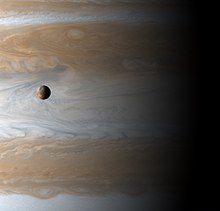Wikijunior:Solar System/Jupiter/Io
Io Facts:
- Io is the most volcanically active body in the Solar System.
- Io is one of the few moons to have an atmosphere although it is very thin.
- At any given time, there are approximately 9 volcanoes erupting on Io.
- Io is so close to Jupiter that Jupiter causes "tides" in its surface. These "tides" are what makes it so volcanically active.
- Io is one of only five of Jupiter's moons that can eclipse the Sun as seen from Jupiter.
- Io is the fourth-largest moon in the solar system.

Io is the innermost moon to Jupiter. Be careful not to confuse Io the moon with 85 Io, an asteroid, or with I.O., an abbreviation that can stand for a number of different things.
How big is Io?
[edit | edit source]Jupiter has 66 moons, but only four are large ones comparable to our Moon. Io is one of these four, and the third largest. Io is 3642.6 km, or 0.28 Earths, wide. It only has a mass of about 1.4% of the mass of Earth. It is a similar size to our Moon (but a lot more exciting!).
What is its surface like?
[edit | edit source]
Unlike most moons, Io has a "young" surface. Because there is so much volcanic activity, the surface is almost free of craters. Also, its volcanoes are quite unusual. Because of the low gravity of Io and the explosiveness of the volcanoes, sometimes they eject material as far as 500 km above the ground. 500 km is more than the distance from ground level on Earth to the International Space Station. Sometimes the volcanoes erupt more calmly, more like geysers on Earth. There are also shield volcanoes on Io, formed mostly from lava flows.
The temperature of Io varies wildly. At some spots, near volcanic eruptions, the temperature is very hot. But most of Io is very cold, as it is so far away from the sun. The average temperature of Io is -143°C. This is much colder than −90°C, the coldest it gets in Antarctica.

In addition to volcanoes, Io also has many mountains, lakes of molten sulfur, calderas, and flows of molten sulfur or silicate hundreds of kilometers long. The colour of the surface is due to sulfur being at different temperatures. When sulfur warms up and cools down, it changes colour. This is why the surface of Io has so many colours. Some people think it looks like a pizza!
Io has 10 named regions (regions on the Earth would be the Middle East, the Far East, the West, etc) which all end in the word Regio, which means in Latin Region. All of the regions are named after ancient kingdoms and empires of Earth, similarly to how most planets and stars are named after gods and other characters from mythology. For example, the largest regio, Colchis Regio correlates to Colchis Kingdom in 550-164 BC.
Io's volcanic features are all based on various beings in mythologies other than Greek mythology and Roman mythology. For example, Masubi is a volcano, but in Japanese mythology, he is the deity of fire who is said to have caused 8 volcanoes on earth. Another example would be another volcano named Ra. Ra in Egyptian mythology was the god of the sun.
Io's mountains are a mix of many mythologies, in the aspects of their names. They all end in several Latin words vaguely meaning mountain. Danube Planum is based on the Danube river, which runs from southwest Germany to the Black Sea, while Egypt Mons is based on Egypt. On the other hand, there are mountains such as Epaphus Mensa, named after Epaphus, son of Io and Zeus; and Ot Mons — in Mongolian mythology, Ot Ene (the final "e" is pronounced) is the goddess of marriage, who was born at the beginning of the world, when the sky and the earth separated.
How long is a day on Io?
[edit | edit source]
It takes 42 hours (1¾ Earth days) for Io to rotate on its axis. It also takes 42 hours for Io to complete one orbit around Jupiter. Since these numbers are the same, it means that the same side of Io always faces Jupiter. (Earth's moon is the same way, which is why you can always see the Man in the Moon.)
Who is it named after?
[edit | edit source]Io (Ancient Greek Ἰώ) — pronounced eye-oh — is named after one of Zeus' (Jupiter's) 1000 lovers. She was a nymph. Nymphs are spirits of nature, associated with water, forests, and grottoes. According to the legend, Io was transformed into a cow by Zeus in order to hide her.
How would Io's gravity pull on me?
[edit | edit source]If you stood on the surface of Io, you would weigh less than you do on Earth. A person who weighs 200 pounds (90kg) on Earth would weigh about 36 pounds (16kg) on Io. So the gravity, of course, pulls less on you.
How was it discovered?
[edit | edit source]
Io was discovered by both Simon Marius and Galileo Galilei. Galileo discovered it on January 7, 1610, and Marius discovered it around the same time.